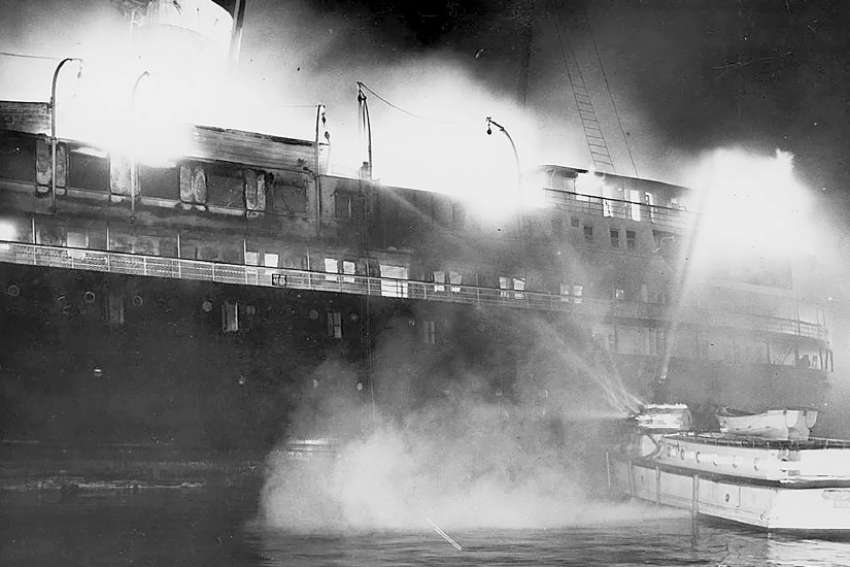St. Michael’s Hospital in Toronto added an inspiring page to its history when at 2:45 a.m. on Saturday, Sept. 17, the stillness of the night hours was broken by the warning of the terrible disaster that had occurred to the lake steamer Noronic which, while lying in Toronto harbour with between 600 and 700 souls on board, had become a blazing furnace within a few minutes of the fire alarm being given.
St. Michael’s was the nearest hospital and as soon as it received the telephone message to prepare for the reception of injured, all available doctors and nurses and other needed workers were summoned. Doctors came at once from all parts of the city, including some who are not on the staff of the hospital.
The Sisters in charge of the various departments of the hospital rose immediately from their beds. The Sister Superior was seen in the storage room hauling out beds which were set up in the corridors and she was later in the kitchen making coffee for the injured. Nurses left private patients to help in the emergency and it was noted that none of the patients afterwards complained of neglect.
Dr. Paul McGoey was on his turn of duty in the emergency ward when the warning came quickly followed by the injured who were brought in ambulances and taxis. Dr. McGoey was not without experience of this kind of emergency for he was called to attendance at the Coconut Grove fire at Boston some five years ago which caused over 200 deaths. Dr. McGoey was soon joined by Dr. Keith Walsh, the chief surgeon, who, though he had been operating all day on Friday and carried out the regular operations on Saturday, came at once for his night duty.
Dr. Ed Brooks, chief of the medical staff, also came and Dr. George Culman, chief resident surgeon, was on hand. Every intern on the staff worked during the night.
The patients, as they were brought in, were taken to a doctor who diagnosed the conditions and indicated the treatment required. Nurses would then take the patient for bandaging or operation or whatever was needed. The different medicines were made available as ordered. Altogether between 70 and 80 patients were brought in. Most of them were able to sit and it was noted that they were more than willing to wait their turn and sometimes they would ask a doctor or nurse to attend first to another patient whose injuries seemed to be worse than theirs. All except 25 of the patients were able to leave the hospital immediately after treatment.
The patients seemed less concerned about their injuries than about the fate of their friends and relatives on the doomed ship. No deaths took place in the hospital though two dead bodies, apparently cases of drowning, were brought in. One of the works that Sisters, nurses and priests took on themselves was to communicate with relatives by long-distance telephone and other means to assure them of the safety of relatives.
Fr. Charles Wigglesworth, chaplain of St. Michael’s Hospital, rushed by ambulance to the waterfront to see if any victims could be given spiritual aid. It was impossible for him to get on the ship and though doused with water he attended to the injured who were being sent in ambulances and taxis to hospitals. Fr. Wigglesworth says that judging by those who came to St. Michael’s Hospital, about one-sixth of those on the Noronic were Catholics.
There were a number of the survivors at Mass at St. Michael’s Cathedral on Sunday morning. Priests of the Cathedral, of St. Mary’s Church and of the Jesuit seminary were on duty from early morning to late at night Saturday and Sunday at the Horticultural Building in the Exhibition grounds where the dead bodies recovered from the ship and the water were laid out. They were being visited by relatives, some of whom came from the United States by airplane. The priests gave what consolation they could and made themselves bearers of messages to distant places.
On Monday morning Solemn Mass for the dead victims was celebrated in St. Michael’s Cathedral by the rector, Fr. Bernard Kyte. His Eminence Cardinal James McGuigan and His Excellency Bishop Benjamin Webster were in the sanctuary. Msgr. John Edward Ronan directed the Cathedral choir.
After the Mass the Cardinal addressed the congregation, expressing sympathy with the relatives and friends of those who had lost their lives in the terrible tragedy. In that Solemn Requiem Mass, said His Eminence, the Church poured forth the prayer: “Eternal rest grant to them, O Lord, and let perpetual light shine upon them.”
(To explore more from The Catholic Register Archive, go to catholicregister.org/archive)


